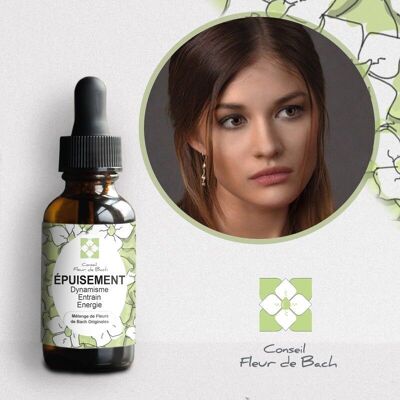
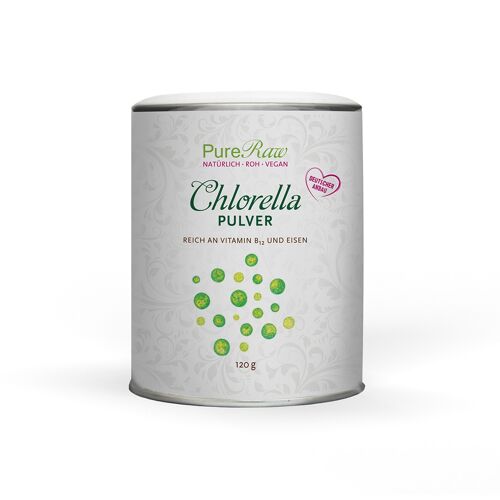
Chlorella powder (Germany), (raw) 120 g
Our chlorella powder from Germany in exceptional PureRaw quality - raw! -100% pure chlorella algae -Rich in natural vitamin B12 -Rich in iron -Natural source of spermidine -Raw food quality -From German cultivation -Regional product -Constant quality controls -Without additives The Chlorella freshwater algae is a spherical microalgae and is one of the oldest plants on our planet. Affectionately called the “green round”, it is particularly popular as a valuable food and superfood among health-conscious people and athletes. What is particularly noteworthy is its high content of bioactive vitamin B12 (100 µg/100 g)1 and iron (80 mg/100 g)2, which makes the algae not only interesting for vegans. Vitamin B12 and iron contribute, among other things, to the reduction of tiredness and fatigue, as well as to the normal function of the immune system and energy metabolism. Our chlorella algae are grown in a 500 km long glass tube system filled with spring water in a greenhouse in Germany. This special method allows sunlight to reach the algae from all sides. This also prevents pollutant deposits, such as those caused by leaching from concrete pools, rain, dust or flying insects. The spring water for growing our chlorella comes from approx. 45 m depth. It is an artesian system. The water is free of anthropogenic contaminants. It does not need to be filtered or otherwise processed. After gentle spray drying, the algae are then ground into powder so that their valuable ingredients are protected and preserved. The result is a unique chlorella powder of premium quality that you can taste and feel. Constant quality controls also guarantee a natural product of the highest quality. The pleasantly mild, nutty taste of our chlorella powder makes it ideal for refining smoothies, juices, desserts, cakes or salad dressings. Ingredients: Chlorella vulgaris Recommended dosage: Stir 1 teaspoon (3 g) into liquids daily. Please consume promptly after stirring into liquid. Storage: Protect from heat, light and moisture Average nutritional values per 100g Energy kJ (kcal): 1563 kJ / 373 kcal Fat: 9.1g - of which saturated fatty acids: 2.6 g - monounsaturated fatty acids: 1.09 g - polyunsaturated fatty acids: 4.51 g Carbohydrates: 15g - of which sugar: 1.9 g Fiber: 16.5g Protein: 49.6 g Salt: 0.04g Vitamin B12¹: 100 µg Iron²: 80 mg NRV = nutrient reference value ¹% NRV: 100 g corresponds to 4000% of the recommended daily dose of vitamin B12 ²% NRV: 100 g corresponds to 571% of the recommended daily dose of iron Average nutritional values per daily dose (3 g) Energy kJ (kcal): 47 kJ / 11 kcal Fat: 0.3g - of which saturated fatty acids: < 0.1 g - monounsaturated fatty acids: < 0.1 g - polyunsaturated fatty acids: 0.1 g Carbohydrates: 0.5g - of which sugar: < 0.1 g Fiber: 0.5g Protein: 1.5g Salt: <0.01g Vitamin B12¹: 3 µg Iron²: 2.4 mg ¹% NRV: 3 g corresponds to 120% of the recommended daily dose of vitamin B12. ²%NRV: 3 g corresponds to 17% of the recommended daily dose of iron. Typical medium composition: Pigments per 100 g of product Total chlorophyll 2.4g Total carotenoids 170 mg Lutein 150 mg Vitamins per 100 g of product Vitamin K 33 mcg Vitamin B6 1 mg Vitamin B9 (folic acid) 610 mcg Vitamin B12 100 mcg vitamin C 19 mg Vitamin E 6 mg Minerals per 100 g of product Calcium 316 mg potassium 1496 mg Magnesium 318 mg iron 80 mg zinc 4 mg Amino acid spectrum % A.s./∑à.s. Aspartic acid 9.5% threonine* 5.0% Serine 3.9% Glutamic acid 11.9% Glycine 6.0% Alanine 9.0% Cysteine 0.5% methionine* 2.2% isoleucine* 4.4% Leucine* 9.5% Tyrosine 3.5% phenylalanine* 6.1% lysine* 8.1% histidine* 2.0% Arginine 6.5% Proline 5.3% tryptophan* 2.4% Valine* 6.6% * Essential amino acids Fatty acid spectrum % F.s./∑Fs. C16:0 palmitic acid 25.2% C18:0 stearic acid 2.6% C18:1 oleic acid 5.2% C18:2 linoleic acid 19.3% C18:3 α – linolenic acid 30.7% Important instructions: - Naturally contains sulfites. The fluctuation range is between < 10 mg/kg – approx. 30mg/kg. Sulfites are not added to the product. -May contain traces of nuts. -Iodine is only present in trace amounts. -It is a natural product whose composition is subject to natural fluctuations. As with other foods, possible intolerances, allergies or hypersensitivities to microalgae cannot be ruled out. If you have a negative reaction to this product, you should stop using it immediately. Please seek advice from your doctor or alternative practitioner if you wish to use this product and if you are pregnant or breastfeeding. We would like to point out that, for legal reasons, the health effects of foods (including dietary supplements) cannot be advertised in Germany. Answers to frequently asked questions (FAQ): What form of vitamin B12 is contained in PureRaw Chlorella? Only bioavailable forms could be detected in our chlorella: a mixture of adenosyl-cobalamin (approx. 76%) + methyl cobalamin (approx. 14%) (both vitamin effective) and traces of hydroxo-cobalamin (approx. 10%) (is converted by the body into the vitamin-effective form). Find out more about chlorella and vitamin B12: Link: https://www.paracelsus.de/magazin/issue/201503/algae-as-a-natural-vitamin-b12-source What is the packaging made of? Our Chlorella is optimally protected with our membrane can and an aluminum-free inner coating (SIOx). The lid is made of plastic and the tinplate base gives the can more stability. These packaging materials are particularly suitable for food products, their shelf life, aroma and moisture protection. Does chlorella contain spermidine? Yes - and in impressive quantities. While wheat germ, soybeans or pumpkin seeds are valued as natural sources of spermidine, chlorella contains around 630 - 1000 mg/kg, many times this amount and is therefore a particularly rich, plant-based source. The daily dose of 3 g of chlorella contains approx. 2-3 mg spermidine. Is Chlorella pyrenoidosa or Chlorella vulgaris better? It has been known since 1992 that the former does not exist at all. It is an outdated scientific term. Do Chlorella cell walls need to be broken down? In fact, studies have shown no significant increase in bioavailability through micronization, i.e. breaking down the cell membranes. The type of drying is much more important. Rack dryers used to be common. However, the digestibility could be significantly increased by spray drying. It is also little known that chlorella with broken cell walls binds heavy metals less well than the intact version. Find out more about chlorella and broken cell walls: Link: https://weltderalgen.wordpress.com/2014/09/29/on-the-question-of-whether-chlorella-cells-need-to-be-broken-broken-cell-wall-micronized-or-not/ How much chlorella can I take per day? Recommended consumption: About 1 g per 25 kg of body weight. Tablets: Take 2 x 5 tablets per day (10 tablets of 300 mg = 3 g) with a little water. Chlorella for the first time? Start with a small dose daily and gradually increase it to the recommended amount. The dosage of Chlorella can be adjusted to individual needs. Does chlorella contain sugar? The sugar content in the nutritional information is not added sugar. These are natural plant ingredients. Sugar is a product of photosynthesis and is found in all plants. Is salt added to the glass tubes of chlorella? No, no salt (sodium chloride) is used to cultivate chlorella algae. Does chlorella contain iodine? Since Chlorella is a freshwater algae, there is no source of iodine in the medium and therefore no iodine can be accumulated there. Iodine is only present in trace amounts. How does chlorella affect health? Since we are hardly allowed to make any statements on this, we recommend reading the special edition 04/2017 "The microalgae Chlorella" from "Die Naturheilkunde" from Forum Medizin Verlag, in which qualified biologist and algae specialist Jörg Ullmann from the algae farm in Klötze explains the stand the science of chlorella and its effective mechanisms of action to support natural detoxification are discussed. The article discusses, among other things, Chlorella species; the potential of microalgae to mobilize, bind and remove harmful substances such as dioxins, pesticides or heavy metals such as lead, mercury or arsenic; antioxidants contained and the antioxidant potential; effect on the immune system; and quality criteria of chlorella products. Many basic questions about chlorella that keep coming up are answered here and false information that causes confusion is cleared up. You can find some examples on this page. You can also find a lot of information in the author's blog "The World of Algae".
PureRaw store also offers

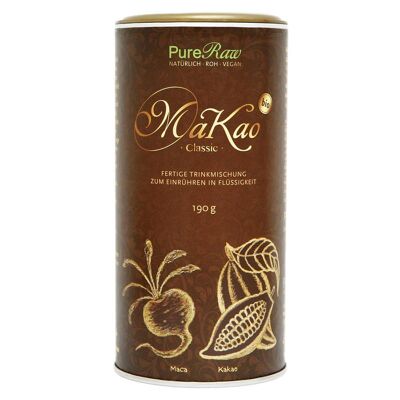
MaKao Classic (Bio & Roh) 190 g
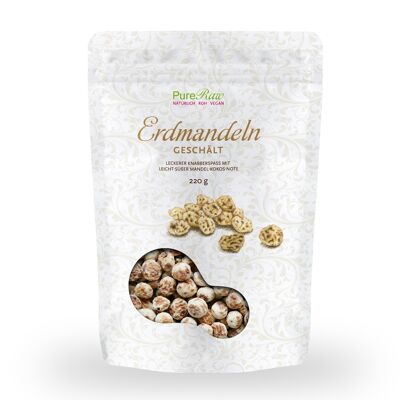
Erdmandel Kerne / Tigernuts (Roh) 220 g
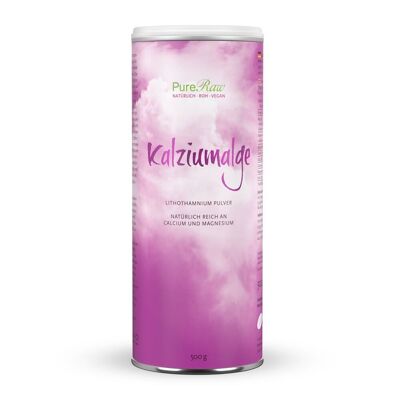
Kalziumalge, Lithothamnium Pulver (Roh) 500 g
Products you may like
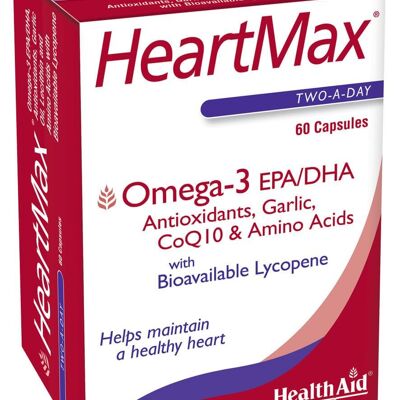
HeartMax Capsules

Bédouze Fruit de la Passion – Comprimés à croquer – Vitamine B12
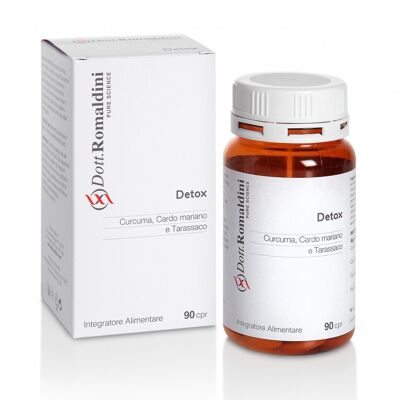
Detox
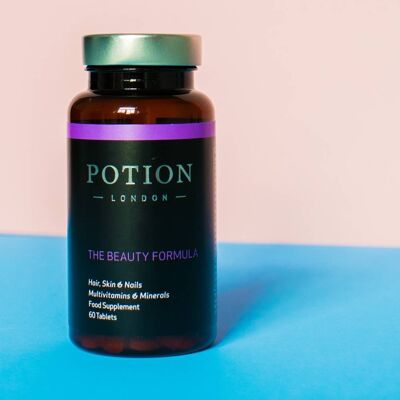
The Beauty Formula Beauty & Health Supplements
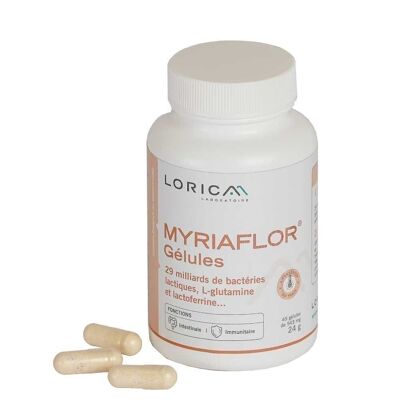
Complément alimentaire naturel - Myriaflor® (Gélules)
